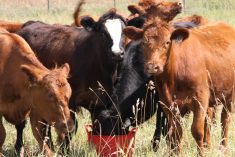RIMBEY, Alta. – When curious people ask rhea producers what their long-legged birds are for, they’re told about meat and oil.
Promoting the unusual possibilities for this South American cousin of the ostrich is part of the agenda for the newly formed Canadian Rhea Association.
The most unique quality is the oil-producing capacity of the bird. Experiments are ongoing using rhea oil as a lubricant for metalworking and ceramic cutting. There is also an unexpected use in baby formula and sunscreen.
These exciting possibilities can only come true if producers build bird numbers, said association director Ron Bradley of Rimbey. The 48-member association is tallying the number of birds in Canada.
Read Also

Animal protection delivery to change in Saskatchewan
The Saskatchewan government is looking for a new agency to handle animal welfare after Animal Protection Services of Saskatchewan decided not to renew its contract next year.
About five litres of oil can be rendered from a single bird. The oil comes from the bird’s fat reserves and remains liquid at room temperature.
Some American researchers said the oil profile is similar in fatty acid content and nutritional value to human milk, said Bradley.
Other researchers are investigating the use of egg shells for artificial human limbs. The shell is a mass of closely-knit fibres with a high calcium content.
Since 1991, Bradley has raised the birds on his central Alberta farm. He now has 43 birds on the farm and says he’s able to earn a comfortable living from collecting, hatching eggs and raising chicks.
Potential income “phenomenal”
“For the amount of income you can have from two or three acres, it’s phenomenal.
“They’re very easy to raise with a little bit of common sense and managerial skills,” he said.
Although the meat is similar to beef, Bradley doesn’t see these birds as a big threat to the beef industry. It’s a lean, low-cholesterol meat cut from the backs and thighs. It will likely find its way into processed meat and special ratite cuts.
Ratite is the umbrella term used to describe flightless birds like ostriches, emus and rheas.
Capturing a share of the market
“If the ratite industry in North America absorbs one percent of the beef market … that equates into about six million birds a year,” he said.
The birds are about 1.5 metres high and range from grey to white in color. He estimates feed costs at about 25 cents a day per bird. They are fed a special ratite ration, although Bradley has noticed they like dandelions, grass, leaves and lettuce.
When they’re young the birds must be watched closely for impaction.
“You have to make sure the grass is very short, keep an eye on them and make sure there is grit in their feed,” he said.
Rheas begin breeding at two years, producing 20 to 40 eggs a season. The male takes care of the housekeeping chores by digging a nest, collecting the eggs, incubating and protecting the nest.
Bradley collects the eggs and places them in a small incubator in his basement where they take 38 to 40 days to hatch. Last year 90 percent of his eggs hatched.
The eggs weigh about 400 to 700 grams and must be gathered regularly. Cold will kill an embryo, said Bradley.
Hatching the eggs is as hectic as calving. The egg shells are tough and the rheas sometimes need help cracking through.
Buyers should look for alert birds with nice plumage, straight legs and a well filled-out body. Bradley recommends people go directly to a reputable breeder’s farm to see and buy birds.















